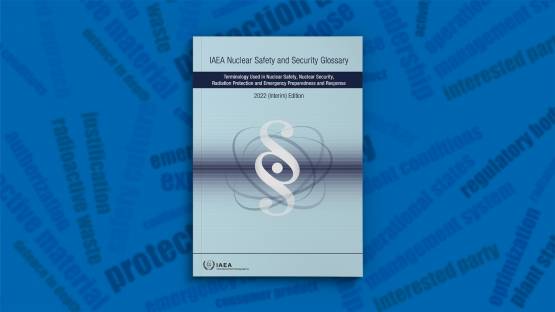In nuclear safety and security, what is meant by a cliff edge effect?
What is cloud shine?
And how does it differ from ground shine?
The new IAEA Nuclear Safety and Security Glossary, available in print and digitally, explains these and more, collecting definitions and explanations of technical terms used in the IAEA safety standards and nuclear security guidance in a single publication, and providing information on their usage to promote consistency in the use of terminology.
“The IAEA safety standards and nuclear security guidance are used by experts and organizations across the world,” said Katherine Asfaw, a Senior Standards Specialist at the IAEA’s Department of Nuclear Safety and Security. “The IAEA Nuclear Safety and Security Glossary provides a list of terms and definitions that have been established in IAEA safety standards and nuclear security guidance published up till 2022. It also provides additional explanations on their use in the safety standards and nuclear security guidance, so that these publications can be used in a consistent and harmonized way, no matter the application.”
There are more than 130 publications in the IAEA Safety Standards Series, and more than 40 publications in the IAEA Nuclear Security Series, all covering specific aspects of nuclear safety and security. These series serve as a global reference and shared resource for national regulatory bodies and other competent authorities, drafters of national legislation, international organizations, and organizations that design, manufacture and operate nuclear facilities, as well as those involved in the use and application of radiation technologies. The IAEA publications are also used as an international benchmark for nuclear safety and security peer reviews and advisory services.
The IAEA Nuclear Safety and Security Glossary explains the meanings of technical terms and any specific meanings ascribed to common words or terms in a particular context. For example, ‘radioactive’ usually refers to something that exhibits the phenomenon of radioactivity and so is taken to include everything that is radioactive. However, in the regulatory context, the term refers to material or waste that is subject to regulatory control by virtue of the radiological hazard that it poses – thereby usually excluding material with very low concentrations of radionuclides or naturally occurring radionuclides.
The Glossary also explains the connections and differences among similar terms. “When used in the safety standards, the term ‘detection’ for instance, may refer to detection by an instrument of radiation from radioactive material. In the nuclear security guidance, however, the same term refers to detecting a nuclear security event,” said Asfaw.
The publication includes valuable information on interpretation of terms and ways of using the Glossary, for editors, reviewers or drafters, or for those using IAEA safety standards and nuclear security guidance or referring to the terminology in their work.
A work in progress
For a term to be included in the Glossary, it must have already been defined in published IAEA safety standards or nuclear security guidance. The IAEA Safety Glossary was first published in 2007 and a revised edition was issued in 2018, taking into account new terminology and usage in Safety Requirements publications issued from 2007-2018.
The 2022 Edition of the IAEA Nuclear Safety and Security Glossary represents the first attempt to provide harmonized guidance to drafters and users of both safety standards and nuclear security guidance. It has been issued as an interim edition, because it is recognized that there are several terms and definitions, particularly in the area of nuclear security, where differences in usage still need to be reconciled and further harmonization is necessary. The Glossary is, therefore, intended as the basis for a longer-term discussion and consultative process and will be reviewed and revised reflecting the developments in both series of publications.
An electronic version of the Glossary has been integrated with the IAEA Nuclear Safety and Security Online User Interface (NSS-OUI), a resource facilitating direct access to the content of the safety standards and nuclear security guidance and navigation within the text.





